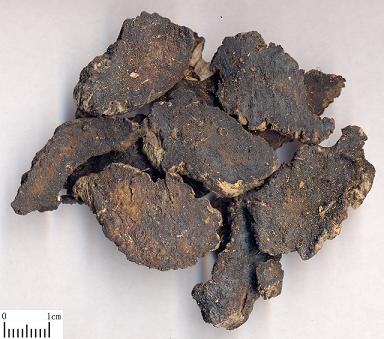Sheng Di
The Processing of Sheng Di
Origin
The root tuber of perennial herbaceous plant Rehmannia glutinosa Libosch of family Scrophulariacea.
Location
Mainty in Henan and Hebei provinces, Inner Mongolia Autonomous Region as well as northeast of China.
Harvest
Collected in autumn.
The actual smell and taste
The fresh one known as Xian Di Huang is fragrant smell, slightly sweet and bitter taste. The dry one known as Sheng Di Huang or Gan Di Huang has no smell but slightly sweet taste.
Best quality
Thick with red-yellow color is top quality for Xian Di Huang, and good Gan Di Huang is marked by large, heavy with dark oily cross section.
The Effect of Sheng Di
Property
Sweet, bitter, cold; heart, liver, stomach and kidney meridians entered.
Actions
Clear heat and cool blood, stop bleeding, nourish yin
Indications
A. Heat entering nutrient-blood in warm diseases
It can cool blood, stop bleeding, nourish yin especially for nutrient-yin deficiency or bleeding due to blood heat in nutrient-blood system and it excels in clearing heat especially in nutrient-blood system in warm diseases. For heat syndrome in nutrient and blood systems leading to nutrient-yin consumption manifested as fever aggravated at night, thirsty, red tongue without coating, it is often combined with herbs of clearing heat from qi system and herbs of clearing heat and removing toxicity so as to clear nutrient and transfer heat out, such as Jin Yin Hua, Lian Qiao, Zhu Ye in Qing Ying Tang from Wen Bing Tiao Bian. For heat syndrome in blood system under the condition of both blood heat with excessive toxicity manifested as coma, delirium, crimson tongue and bleeding due to blood heat manifested as hematemesis, apostaxis, hematochezia, macula in dark purple color, it is commonly combined with herbs excelling in activating blood and resolving stasis, clearing heat and cooling blood for the purpose of mutually reinforced the effects of heat-clearing, stasis-resolving, blood-cooling and bleeding-stopping. For example, Shui Niu Jiao, Chi Shao, Mu Dan Pi in the formula Xi Jiao Di Huang Tang from Qian Jin Fang. For heat disease in terminal stage with lingering heat manifested as fever aggravated at night while alleviated at morning, red tongue and rapid pulse, it is combined with deficiency-heat-clearing herbs for mutual reinforcement such as Zhi Mu, Qing Hao, in Qing Hao Bie Jia Tang from Wen Bing Tiao Bian, in which Di Huang plays the role as clearing lingering heat in blood as well as nourishing yin to promote body fluid.
B. Bleeding due to blood heat
It is commonly indicated for hematemesis, emptysis, hemoptysis, hemafecia, hematuria, metrorrhagia and metrostaxis caused by excessive heat in zang-fu organs forcing blood because of its actions of stopping bleeding and cooling blood as well.
It is often combined with herbs of cooling blood and stopping bleeding, such as Raw Ce Bai Ye, Raw He Ye in the formula Si Sheng Wan from Fu Ren Da Quan Liang Fang (Effective Prescriptions for Women).
C. Syndrome of yin deficiency
It can nourish yin, clear heat as well as nourish yin in zang-fu organs to purge fire, moisten dryness and promote fluid production, so it excels in treating thirsty and constipation in dryness-heat syndrome due to yin-deficiency especially for stomach yin deficiency by its action of promoting fluid production. For syndrome of interior heat caused by yin-deficiency manifested as bone-steaming tidal fever, it is often combined with herbs of nourishing yin and purging fire, such as Zhi Mu and Di Gu Pi, etc. For body fluid deficiency and polydipsia in warm disease. It is often combined with stomach-yin-nourishing herbs to promote body fluid and relieve thirst, for instance, Mai Dong, Bei Sha Shen, Yu Zhu, as in Yi Wei Tang recorded in Wen Bing Tiao Bian. For yin-deficiency syndrome manifested as diabetes and polydipsia, it is reinforced by the combination with qi-replenishing and body-fluid-promoting herbs like Shan Yao, Huang Qi and Shan Zhu Yu, etc. For intestine dryness and constipation due to yin consumption, it is combined with herbs of nourishing yin and moistening dryness to mutually take effects of increasing fluid and relaxing bowels, for example, Xuan Shen and Mai Dong, etc., as in Zeng Ye Tang from Wen Bing Tiao Bian. For chest, stomach and hypochrondriac pain as well as dry mouth and throat caused by liver and kidney yin-deficiency which lead to blood and body fluid consumption, it is often combined with herbs of nourishing yin and moistening dryness, such as Sha Shen, Mai Dong and Gou Qi, as in Yi Guan Jian from Liu Zhou Yi Hua (Liuzhou Medical Talks). For syndrome of lung and kidney yin-deficiency with symptoms as dry cough and hemoptysis, it is reinforced by the combination with lung-yin-nourishing and cough-stopping herbs. For instance, Bai He, Bei Mu, Xuan Shen and so on in Bai He Gu Jin Tang from Yi Fang Ji Jie. For restless and insomnia caused by heart and kidney yin-deficiency, it is commonly combined with other yin-nourishing, dryness-moistening and tranquilizing herbs, such as Tian Dong, Mai Dong, Wu Wei Zi and so on in Tian Wang Bu Xin Dan recorded in She Sheng Mi Pou (Secrets of Health Preservation).
Dosage and Administrations
Decoct 10~15g. Take 20~30g when the fresh is used. Freshly ground juice will strengthen the action of heat clearing and blood cooling.
Cautions
It's contraindicated in cases of diarrhea, abdomen distention due to spleen deficiency.
